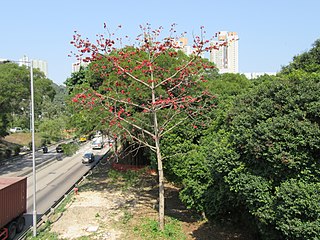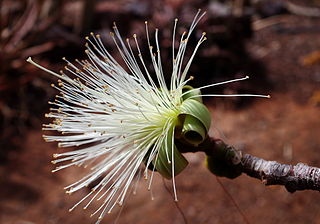
Ceiba pentandra is a tropical tree of the order Malvales and the family Malvaceae, native to Mexico, Central America and the Caribbean, northern South America, and West Africa. A somewhat smaller variety has been introduced to South and Southeast Asia, where it is cultivated.

The Malvales are an order of flowering plants. As circumscribed by APG II-system, the order includes about 6000 species within nine families. The order is placed in the eurosids II, which are part of the eudicots.

Ceiba is a genus of trees in the family Malvaceae, native to tropical and subtropical areas of the Americas and tropical West Africa. Some species can grow to 70 m (230 ft) tall or more, with a straight, largely branchless trunk that culminates in a huge, spreading canopy, and buttress roots that can be taller than a grown person. The best-known, and most widely cultivated, species is Kapok, Ceiba pentandra, one of several trees known as kapok. Ceiba is a word from the Taíno language meaning "boat" because Taínos use the wood to build their dugout canoes.

Abutilon is a large genus of flowering plants in the mallow family, Malvaceae. It is distributed throughout the tropics and subtropics of the Americas, Africa, Asia, and Australia. General common names include Indian mallow and velvetleaf; ornamental varieties may be known as room maple, parlor maple, or flowering maple. The genus name is an 18th-century Neo-Latin word that came from the Arabic ’abū-ṭīlūn, the name given by Avicenna to this or a similar genus.

Bombacaceae were long recognised as a family of flowering plants or Angiospermae. The family name was based on the type genus Bombax. As is true for many botanical names, circumscription and status of the taxon has varied with taxonomic point of view, and currently the preference is to transfer most of the erstwhile family Bombacaceae to the subfamily Bombacoideae within the family Malvaceae in the order Malvales. The rest of the family were transferred to other taxa, notably the new family Durionaceae. Irrespective of current taxonomic status, many of the species originally included in the Bombacaceae are of considerable ecological, historical, horticultural, and economic importance, such as balsa, kapok, baobab and durian.
Cotton tree may refer to:

Bombax ceiba, like other trees of the genus Bombax, is commonly known as cotton tree. More specifically, it is sometimes known as Malabar silk-cotton tree; red silk-cotton; red cotton tree; or ambiguously as silk-cotton or kapok, both of which may also refer to Ceiba pentandra.
Silk-cotton tree is a common name for several plants and may refer to:

Cyclopropane fatty acids (CPA) are a subgroup of fatty acids that contain a cyclopropane group. Although they are usually rare, the seed oil from lychee contains nearly 40% CPAs in the form of triglycerides.

Pseudobombax is a genus of flowering plants in the subfamily Bombacoideae of the family Malvaceae.

Cochlospermum is a genus of trees in the Bixaceae family; some classifications place this genus in the family Cochlospermaceae. It is native to tropical regions of the world, particularly Latin America, Africa, the Indian Subcontinent, and Australia.

Pseudobombax ellipticum, with common names including shaving brush tree,Dr Seuss tree, and amapolla tree, is a species of plant in the subfamily Bombacoideae of the family Malvaceae.

Diembéring is a village in Senegal in the rural community of the same name. It is located in Cabrousse, Oussouye, Ziguinchor, Casamance, approximately 10 km north of Cap Skirring and 60 km from Ziguinchor.

Pachira is a genus of tropical trees distributed in Central and South America, Africa and India. They are classified in the subfamily Bombacoideae of the family Malvaceae. Previously the genus was assigned to Bombacaceae. Prior to that the genus was found in the Sterculiaceae.
Kapok fibre is a cotton-like plant fibre obtained from the seed pods of a number of trees in the Malvaceae family, which is used for stuffing mattresses and pillows, for padding and cushioning, and as insulation.

Euchroma giganteum, the Metallic Wood Boring Beetle or Giant Metallic Ceiba Borer, is a species of beetle in the family Buprestidae, the only species in the genus Euchroma.
Kapok, or Kapok fibre, also known as ceiba and Java cotton, is the fine fibres from the fruit of the kapok tree Ceiba pentandra in the bombax family Bombacaceae.

The Eastern Panamanian montane forests (NT0122) is an ecoregion in the east of Panama and the extreme northwest of Colombia. It contains diverse flora and fauna, with considerable endemism. The ecoregion is largely intact due to its inaccessibility, although the opening of an extension of the Pan-American Highway has introduced threats from human activity.

Pseudobombax septenatum is of the family Malvaceae, commonly known as Algodón de río, beldaco, ceibo barrigón, majagua colorada or barrigon. It is a deciduous tree up to 80 feet in height which grows in semideciduous rainforest with a definite dry season. It is found from Nicaragua to Brazil. Its flowers are cream-colored and like those of Ceiba spp., in forming a roundish cluster of stamens on a stalk surrounding the pistel, in this instance up to one thousand stamens in number. The leaves generally have seven smooth-edged narrowly oblong leaflets. It was originally named Pachira barrigon, and later Bombax barrigon. It has the bright green lines running through the bark that is also seen in Ceiba spp. and Chorissa spp.
















